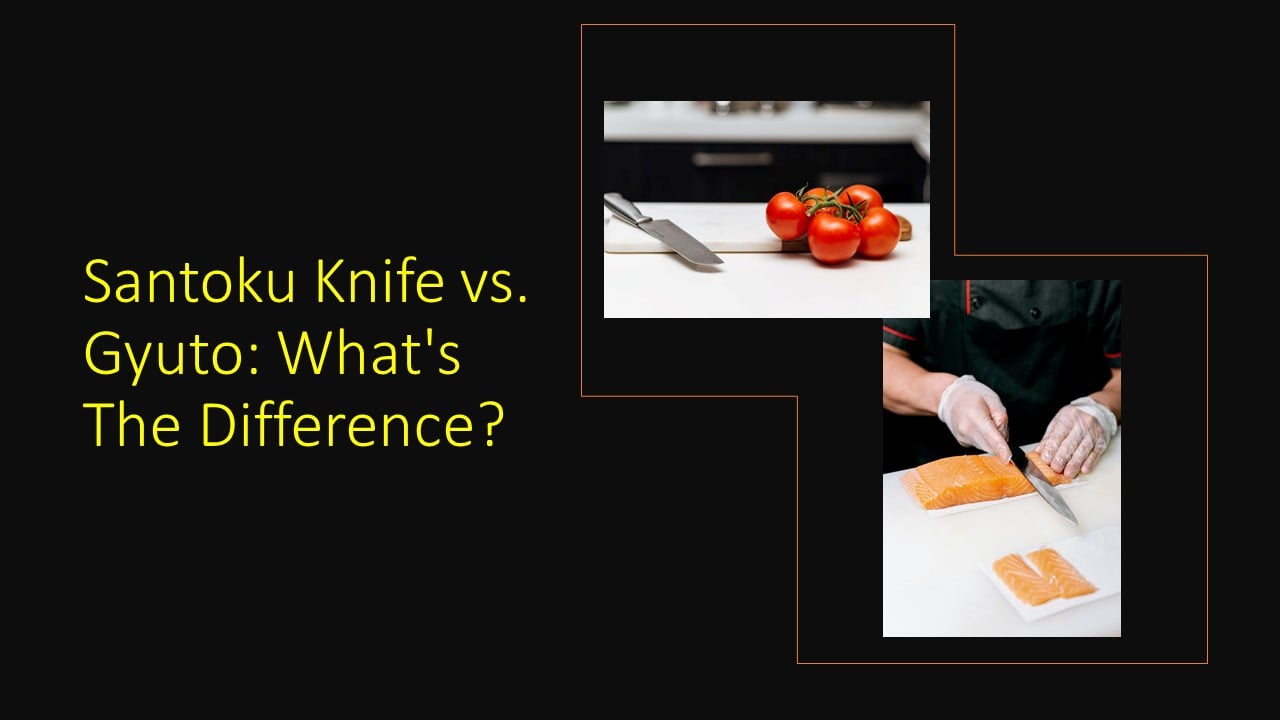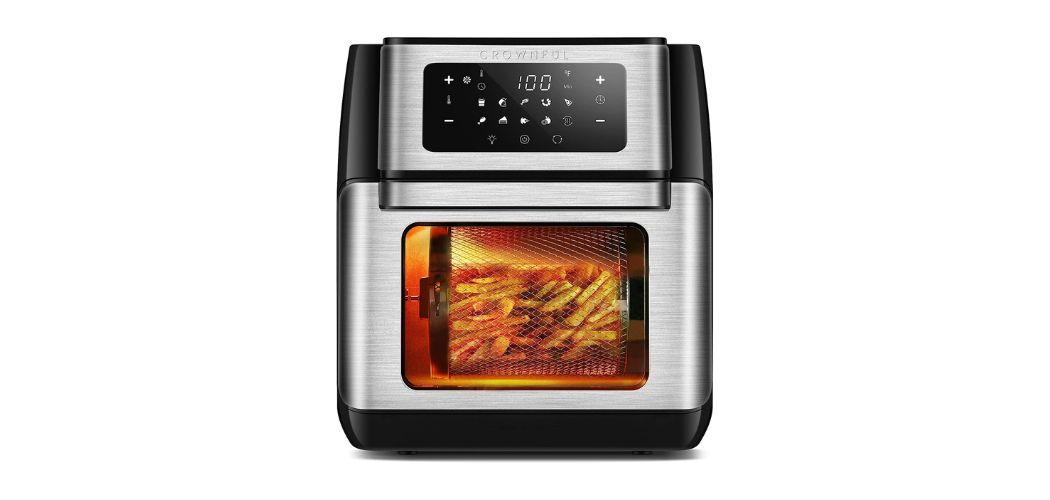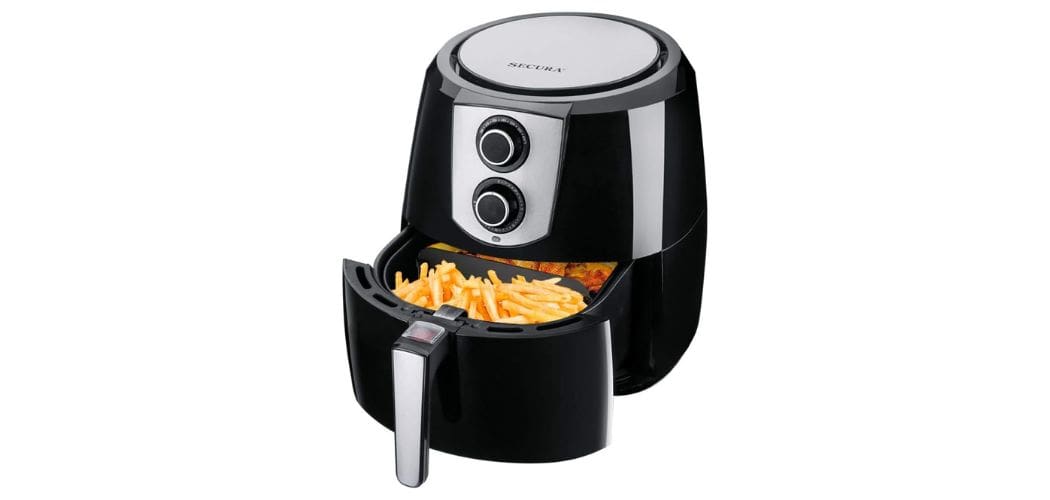Knives made in Japan are more than just helpful kitchen equipment. They are often pieces of art created by artists using old methods and high-quality materials to make blades fit for expert chefs.
Santoku and Gyuto are two of the most famous Japanese kitchen knives. If you’ve just begun looking for a new kitchen knife, these two would be the perfect choice for you.
But what are their differences? Which knife would suit better in your hands? Read on to know all about the Santoku and Gyuto knife and select the one that you find best.
Table of Contents
What Is A Santoku Knife?
The Santoku Knife, like the Gyuto, is a versatile cutter.
The Japanese incorporated the attributes of their native butcher knife into a Western kitchen knife in the 1940s.
The Santoku knife was born as a consequence, and it is now extensively used as safe cookware.
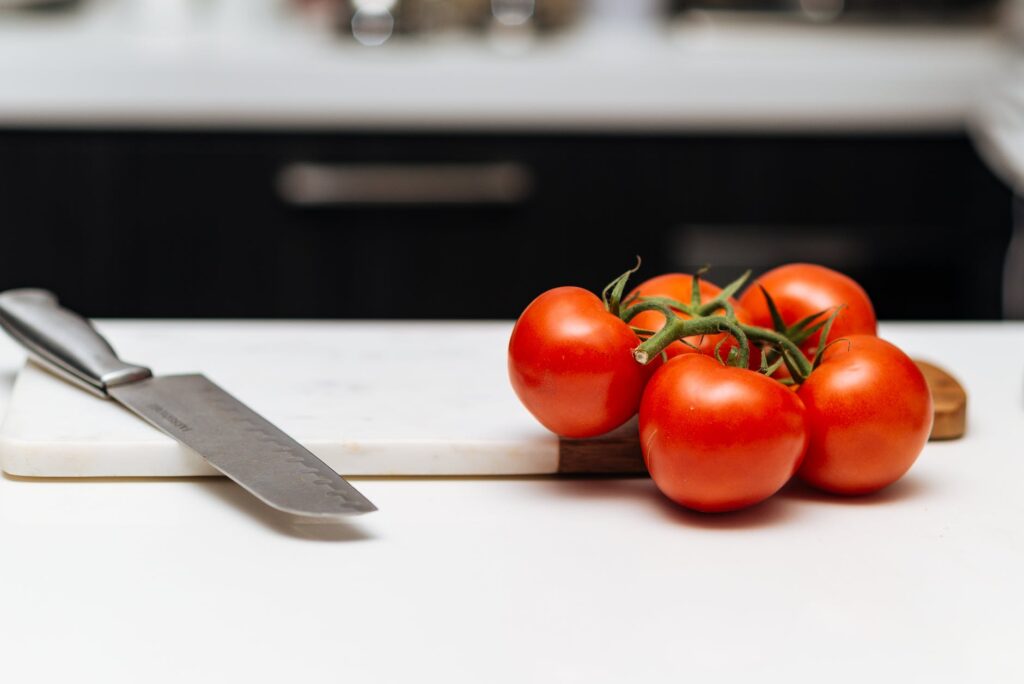
It originated in Japan; however, many people consider it a hybrid of Japanese and Western blades.
People use this knife for various tasks such as cutting, dicing, scooping, and so on. You may use the blade to cut both soft and hard foods, such as fish and meat. As a result, every kitchen has a variety of Santoku knife applications.
What Is A Gyuto Knife?
A Gyuto is a kitchen knife with a double bevel, a tall base, and a comparably slimmer design than a western-style classic blade.
According to the theories, these blades are either French or German.
It was first introduced to the Japanese economy in the second part of the nineteenth century, commonly known as the Meiji period.
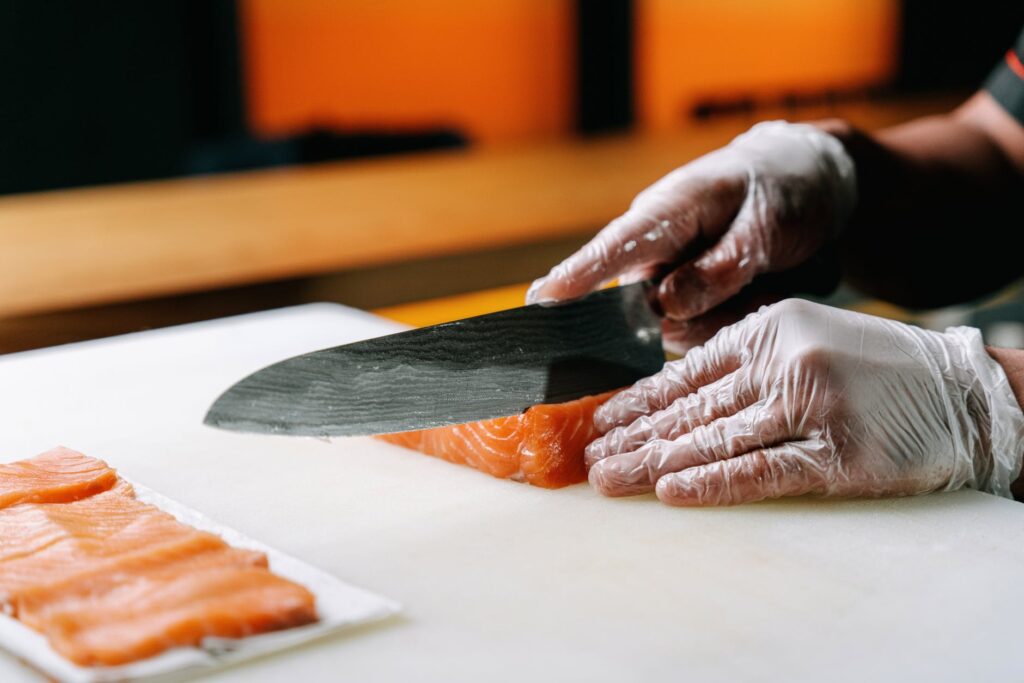
The Japanese business made a few alterations to the cutter’s style after that, and it quickly became one of the various sorts of Japanese blades.
You may use this knife to cut various foods such as fruits, vegetables, herbs, seafood, and meat. Pull-cutting, chopping, and other heavy applications benefit from its tall, curving heel. It’s a versatile kitchen gadget that’s well worth the money.
The Difference Between A Santoku Knife And Gyuto Knife:
Design:
Santoku is immensely popular among Japanese families and has a similar design compared with Japanese knives. This knife is considerably smaller, and it attaches straight to the wrist without the need for support. The Santoku’s point is flatter than any other precision knife, allowing it to work well in cutting.
This flat tip guarantees that it can easily make slicing movements. The blade is narrow and provides greater accuracy than other cheap knives, and balances fine.
It allows you to scrape all of your sliced veggies with ease. The blade design produces more accurate and smoother cuts.
On the other hand, for individuals new to cooking, the Gyuto is a dream come true. It’s incredibly flexible and serves as a replacement for all of your kitchen knives.
The Gyuto’s agility stems from its distinctive design: unlike Western knives, it has a flat base and a balancing point extending farther up the tip.
These characteristics contribute to the clumsy movements that novices often exhibit while learning cutting skills. Beginner cooks will feel at home with the blade profile and will finish the work ahead of them in time.
Length:
The size of the Santoku may be both a benefit and a burden. It’s smaller than the knives you’re accustomed to in a Western kitchen, so it’ll be impossible to handle if you have big hands. This might be a severe issue since Santoku blades are just 5″-7.9″ long.
Santoku knives could be the ideal choice for you if you have tiny hands or don’t like giant blades because they’re too cumbersome. It also makes it simpler to have more accurate slices, while longer blades can easily mess up the objective.
Santoku knives are much shorter than Gyuto knives. With a blade length of 10″ to 12″, you’ll spend less time cutting and chopping in the kitchen. A Gyuto knife, unlike a Santoku knife, uses greater force.
Regardless of their size, you can chop any meat or vegetable. Although professional meat cleavers and nakiri blades are available for chopping meat and vegetables, a Gyuto will satisfy the needs of the ordinary home cook.
Because of the knife’s pointy top, you may strive for more precision while preparing meals. If you’re a beginner cook, though, go with the standard Gyuto sizes rather than the even longer blades used by skilled pros.
Weight:
Santoku is much lighter than other knives due to its compact size. It’s all about the convenience – some cooks would like a knife that they can wield to augment their arm.
While this detracts from the allure of flawless cuts, it may help get more done in less time.
Because the Gyuto knife is much longer than the Santoku blade, it adds to the weight. This is the ideal purchase for anybody who enjoys feeling the importance of their knife when cooking.
Although somewhat heavier, it strengthens the knife and improves the power you can apply to each cut.
Bevels:
Santoku knives are often bevelled on one side. The shortening may identify knives with angles right before the knife’s edge. However, some knives are just honed on one end, while others have chiselling on both ends.
Japanese knives are often single-bevelled because Asian cuisine demands precise cuts. Santoku knives are also single-bevelled; however, due to Western cuisine’s introduction, some Santoku knives are now double-bevelled.
Despite their diminutive size, Santoku knives have a lot of force because of their single-bevelled blades. You can accomplish the precise cut whenever it comes to pieces of meat that demand a lot of accuracy.
Gyuto blades are double-bevelled, and most Western cooks unfamiliar with Asian cuisine would recognize this knife type.
The contrast between a Gyuto knife and a regular double-bevelled Western knife is that Gyuto knives, despite their bevel pattern, are much sharper.
This not only adds to their flexibility when it comes to cutting a variety of foods, but you won’t have to fight with the roughest cuts. It’s a true all-rounder in every sense of the word!
Sharpness:
Santoku knives are significantly sharper than standard chef’s knives since they are generally single-bevelled. This is crucial to take into account when honing or perfecting a Santoku. This knife’s edge bevels anywhere between 12 to 15 degrees, making it incredibly steep.
Consequently, it uses power-slicing, a method that makes your cutting process much more pleasant.
However, it may not be suitable for cutting more complicated cuts of meat, and the edge may be damaged because of that. Meat cleavers are ideal for chopping through tough cuts of meat.
As previously stated, the Gyuto is frequently double-bevelled. Chefs who are used to Western cuisine may find this familiar, although it will significantly reduce the knife’s sharpness.
The Gyuto knife curves at 16-22 degrees on both ends, making it best for power-chopping rather than slicing. It also reduces the precision rating somewhat, leaving you with a blade that can slice through virtually anything but has a much-diminished feeling of accuracy.
Uses:
The Santoku knife is one with “three virtues.” Santoku knives are well-known for their mincing, slicing, and clipping abilities.
This knife is ideal for an agile instrument that can accurately cut tiny foodstuffs due to its blade form and physical qualities.
The three cutting methods of mincing, slicing, and clipping need a blade that cuts quickly and precisely.
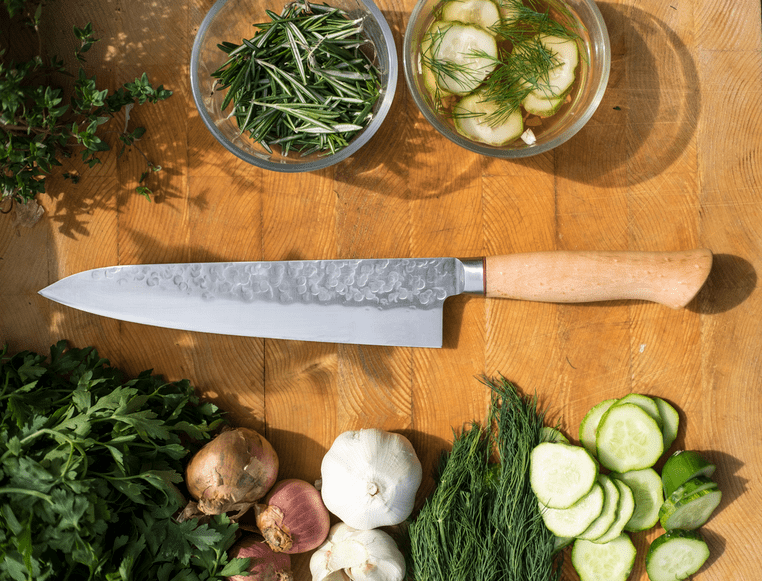
If you’re new to these methods and desire flawless cuts, Santoku knives would be your best mate.
The Gyuto knife, commonly known as the “cow’s blade,” is a kitchen tool in Japanese homes. It’s incredibly adaptable, and you can count on it to get the job done.
It helps with brutal chopping and cubing. Since it’s big and double-bevelled, it can cut through practically any meat or vegetable.
If you use both push and pull strokes in your cooking, the Gyuto knife will last you a long time. It provides greater accuracy than standard Western knives but less than Santoku knives, so bear that in mind while choosing between the two!
Quick Comparison Guide:
| Aspects | Santoku | Gyuto |
| Design | Smaller in size, with a flat tip | Longer knife with a flat base and a balancing point extending farther up the tip |
| Length | 5″-7.9″ long | 10″ to 12″ long |
| Weight | Lighter | Heavier than santoku |
| Bevel | Single bevelled | Double bevelled |
| Sharpness | Sharper | Less sharp |
| Uses | Used in precision cuts | Can be used for rough use |
FAQs
Would A Santoku Knife Fit In My Hand?
To purchase a knife, you must first hold it in your palm to sense the weight and observe the physical characteristics.
Knives are the equivalent of your extended arm. It should feel as though it were made for your hand.
When it comes to choosing a Santoku knife, the same is true. Examine how the blade feels in your hand to see whether it will remain flexible and pleasant even after hours of cutting veggies.
Is It Possible To Chop Meat With A Santoku Knife?
You may use a Santoku knife to cut meat. Cutting bones with a Santoku, however, may be tricky. However, if the meat is boneless, a Santoku knife will suffice.
How To Use A Gyuto Knife?
Gyuto may be used for a variety of things. It’s used for rock chopping or slicing. Except for intricate cutting, complex meals, and carving, the Gyuto knife is suitable for everything.
Final Verdict
When you compare the two knives, you’ll see that they’re both quite proficient. These blades can handle 90% of your cutting requirements. The distinctions between them are minor. But, your cutting habits will play a role in determining the best knife.
If you have to pick one, you may do better with Gyuto because of its bevelled edge and pointy tip. Its length makes more significant cutting projects simple.
Heavy-duty cutting is not recommended with these knives. It’s not a good idea to get one of these to cut through bones.
Whatever knife you pick, bear in mind that it also needs maintenance. To keep your knife sharp, invest in a sharpener.
Alternatively, be ready to get your blade sharpened regularly by a professional. A dull knife is inconvenient to use and even hazardous in the kitchen!

